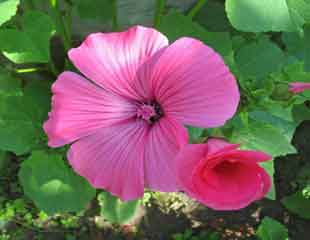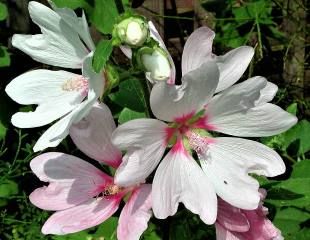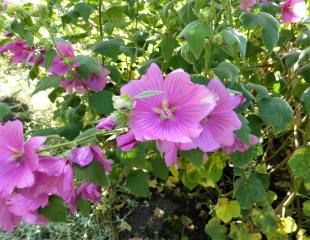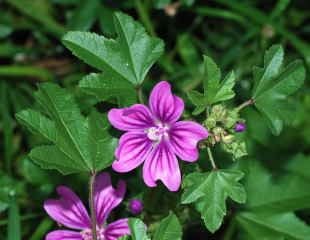


How to grow Lavatera
Lavatera is an easy to grow, deciduous shrub which bears large attractive flowers from mid-summer onwards, covering the shrub with masses of pink/mauve/white flowers. Lavatera is a long flowering but short-lived shrub. It will fill a border space quickly, growing up to 3m and flower until first frosts.
Plant Lavatera in a sheltered spot which has well-drained soil, and full sun. Lavatera is not fussy about soil, and will grow well on poor soils and is suitable for coastal gardens. In cold areas, Lavatera is best grown against a wall to provide protection. Most varieties are fully hardy down to -10, but not L. maritima which needs winter protection.
Lavatera are vigorous and will put on a lot of growth each season but are short-lived. Because of their vigorous growth, Lavatera makes a great addition to fill any gaps in borders with large, saucer like blooms in pinks, white and purple. With the added benefit of long-lasting flowers which are attractive to bees. Dead heading will prolong flowering.

I took this image at an NGS garden and it probably does not do justice to this attractive summer shrub. This variety is probably the commonly grown Lavatera x clementii which grows between 1-2m. Also grown is L. trimestris cultivars, which are annuals. A pretty shrub which bears many flowers, in shades of pink and white with long summer flowering.
There are annual mallows,(L. trimestris cultivars,) perennial and Shrubby Mallows, the latter of which is the Lavatera commonly grown in gardens. There are some good varieties with RHS award of garden merit, worth seeking if you want to buy a Lavatera.
Image top left is Lavatera 'Rosea' ** and centre is L. "Barnsley"*** both of which are amongst the most popular and both with RHS garden merit award. L. barnsley is particularly pretty with its two coloured flowers. Illustrated above right L. 'Kew Rose' which is fully hardy, evergreen in mild areas and semi deciduous colder areas.
Lavatera is tolerant of salt and so suitable for a coastal garden. Most Lavatera are trouble free and will grow on most soils, including poor, dry soil with a preference for good drainage.
How to Prune Lavatera
A hard frost can damage Lavatera and aesthetically, this can look unsightly. The best way to overcome this problem is to prune out the damaged branches in the spring. Also Lavatera can get leggy, and large, and to keep it looking fresh it is best to prune regularly in the spring.
You can prune Lavatera in two stages. If the shrub is large, prune in the autumn reducing stems by 50% to avoid wind rock.
For all other Lavatera prune in spring after all risk of frost has passed. Pruning is simple. You can either prune it down by around a third or half or, since Lavatera responds well to a hard prune, you can cut it down almost to the ground in the spring.
Or as soon as the new shoots can be seen at the base of the plant, and the risk of frost has passed, cut back all the old wood and let the plant re grow new wood which will form the summer's blooms. Lavatera flowers best if it has an annual hard prune which also curtails the plant's natural tendency to become leggy. Lavatera flowers on the current years' growth.
Lavatera can also be an annual, such as the short-lived Lavatera trimestris 'Silver cup' which although classified as annual,it may survive the winter in a very sheltered spot. In northern or exposed areas, it would be necessary to bring under cover for the winter.
Lavatera is short lived, usually becoming very leggy and flowering less by around year 6/7 depending on conditions. It can be propagated from softwood cuttings in spring or summer.

Lavatera is an unfussy, easy to grow summer flowering shrub.
For more ideas on good garden shrubs to grow, check out check out shrubs and bushes; spring flowering shrubs; summer flowering shrubs; shrubs with autumn and winter interest; and evergreen shrubs.
Mallow as a wildflower
Mallow often grows wild, with Malva sylvestris, which is the common Mallow, being a common occurrence. It is a tough, vigorous wildflower which can be found all over Europe and is often included in wild flower mixes.

